Olympus OM-D E-M10 Mark II Review
Olympus OM-D E-M10 Mark II Introduction
The Olympus OM-D E-M10 Mark II is the latest Olympus OM-D. It replaces the original E-M10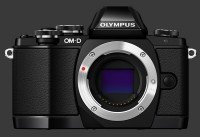
Olympus OM-D E-M10 which introduced an intermediate level camera to the family of Olympus Micro Four-Thirds mirrorless.
The new Mark II version has a nicely upgraded feature-set, now with a 5-axis image-stabilization system and a higher-resolution 2.4 megapixels 0.45" EVF. It retains nearly the same design and ergonomics of its predecessor, including the Eye-Start Sensor and dual control-dials.
A revised anti-alias filter-free 16 megapixels Four-Thirds CMOS sensor paired with a TruePic VII processor allows it to improve on image-quality in low-light and maximize sharpness. It has a standard ISO 200-3200 sensitivity range which expands to a now common ISO 100 - 25600 range. The new processor makes it possible to capture bursts of full-resolution images at 8.5 FPS or record full 1080p HD video at 60 FPS.
Video features of the E-M10 Mark II are extremely sophisticated including Program, Aperture-Priority, Shutter-Priority and Manual exposure as well as Art Filters. Video focus modes include continuous autofocus (AF-C), subject-tracking autofocus and direct manual-focus (DMF). Stereo sound is recorded by a built-in microphone or an external one via a standard mini-jack.
This digital camera review covers the usability, performance and image quality of the Olympus O-MD E-M10 Mark II.
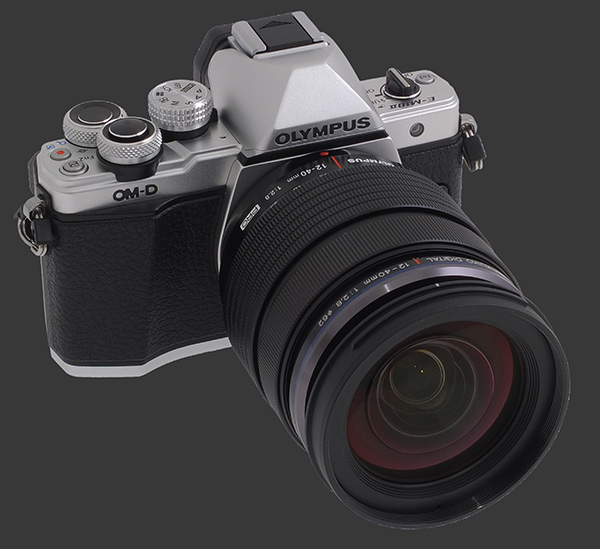
Olympus OM-D E-M10 Mark II Features
Sensor
- 16 Megapixels CMOS Four-Thirds sensor
- No Anti-Alias Filter
- 5-Axis Sensor-Shift image stabilization
- Built-in ultra-sonic dust-reduction
- Micro Four-Thirds lens mount
Exposure
- Standard ISO 200 - 3200 sensitivity range
- Expanded ISO 100 - 25600 sensitivity range
- Auto ISO, customizable ISO 200 - 25600 limit
- ISO Bracketing, 3 frames, maximum 1 EV steps
- PASM Exposure modes
- Program-Shift in P mode
- 1/4000 - 60s Mechanical Shutter-Speeds, 1/3, 1/2 or 1 EV steps
- 1/16000 - 1/8s Electronic Shutter-Speeds, 1/3, 1/2 or 1 EV steps
- Timed or Bulb Exposure, Maximum 30 mins
- EC, ±5, 1/3, 1/2 or 1 EV increments
- Exposure-Shift, ±1, 1/6 EV increments
- Multi-Segment, Center-Weighed, Spot, Shadow Spot and Highlight Spot metering
- Auto-Exposure Bracketing, 3, 5 or 7 frames, max 1 EV steps except 1/2 EV for 7 frames
- Flash Bracketing, 3 frames, maximum 1 EV increments
- FC, ±3, 1/3 or 1/2 EV increments
- Auto, Redeye, Forced, Off, Slow-Sync+Redeye, Slow-Sync, Rear-Sync and Manual flash modes
- Manual flash power between full and 1/64th power
- Remote-Control flash
Image Parameters
- AutomaticTwo types: Normal and Warm-preserving., 7 presetsSunny, Shade, Cloudy, Incandescent, Fluorescent, Underwater, Flash, Kelvin and custom white-balance
- White-balance fine-tuning along 2 axis in 15 steps
- Digital white-balance preview
- White-balance bracketing, 1 or 2 axis, 3 frames along each axis, 3 step sizes
- Optional One-Touch custom white-balance
- Optional Long-Shutter noise-reduction
- Optional High-ISO noise-reduction, 3 levels
- 14 Color and 2 B&W Picture Modes
- Adjustable contrast, sharpness, saturation, 5 steps each
- Adjustable gradation, automatic or 3 levels
- Adjustable tone curve, 15 steps for highlights and 15 steps of shadows
- sRGB or Adobe RGB color space
Output Processing
- 4:3 Native aspect ratio
- 3:2, 16:9, 1:1 and 3:4 cropped aspect ratios
- 12, 8, 5, 3, 2 and 1.2 megapixels modes
- JPEG, RAW, RAW+JPEG capture
- 4 JPEG Compression levels
- Optional Vignetting-Correction
- Optional Keystone-Compensation, 41 steps along 2 axes
Drive
- 8.5 FPS Drive, 22 RAW files or 36 JPEG images
- Multiple-Exposure, 2 frames, optional automatic gain and composition overlay
- Time-Lapse, 1-999 Frames, 1s-24h59m59s Interval, 0-24h59m59s Delay
- Self-timers: 2s, 12s or Custom, 1-10 Frames, 1-30s Delay, ½s-3s Interval
- Anti-Shock Mode: 0-30s Shutter-Delay
- Quiet Modes: Single, Continuous, Timers
Focus
- Single-shot (AF-S), continuous (AF-C), direct manual-focus (DMF) or tracking autofocus
- Manual-focus (MF), optional display magnification up to 14X
- 81-area AF system, automatic or manual point-selection
- Focus-Bracketing, 2-999 Frames, 10 step sizes
- Optional Bulb focusing
- Optional Face-Priority
- Optional AF-Assist lamp
- Optionally reset lens focus to infinity
- Controllable focus-ring direction
Video
- 1920x1080 @ 60 FPS Unlimited Recording
- 1920x1080 @ 60 FPS Super-Fine Quality, Max 8 seconds
- 1920x1080 @ 30 FPS All-Intra Mode
- Quicktime with H.264 codec
- 4K Ultra-HD 5 FPS Time-Lapse Video, Motion JPEG AVI
- Program, Aperture-Priority, Shutter-Priority and Manual video exposure
- Adjustable Audio-Volume, 21 levels
- Optional Stereo Sound
- Optional Volume-Limiter
- Optional Wind-Filter, 3 levels
- Optional Time-Code
- Optional Art-Filters
Display & Viewfinder
- 0.45" EVF, 2.4 Megapixels
- 0.62X Magnification, 100% Coverage
- Built-in Eye-Start sensor
- Digital-level, 2-Axis
- Tilting 3" Touchscreen LCD, 1 Megapixel
- Optional HDR Preview
- Optional Live-Histogram
- Optional Framing-Guides, 5 types
- Optional Blinking-Highlights
- Optional Focus-Peaking
- Adjustable brightness, 15 steps
- Adjustable color, 15 steps, 1 axis
- Optional Touch-Screen controls
Connectivity
- Standard Hot-Shoe
- Built-in WiFi
- HDMI (1080p) output
- A / V (NTSC / PAL) output
- USB 2.0 connectivity
Misc
- Dual control-dials
- Traditional Mode-Dial
- 6 Customizable buttons
- Customizable AE-L metering mode
- SDXC memory slot
- Lithium-Ion battery
- Customizable Battery Warning
- Customizable DPI Setting
- Embedded Copyright Info
Olympus OM-D E-M10 Mark II Usability - How easy is it to use?
The Olympus OM-D E-M10 Mark II has a distinctively angular design with a large viewfinder hump hosting the EVF and hot-shoe. It also has a minimal hand grip which keeps it relatively slim. The camera feels solid in hand with a good weight. Unlike the E-M5 Mark II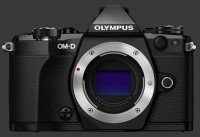
Olympus OM-D E-M5 Mark II which is weatherproof and shares a nearly identical design, the E-M10 Mark II has a much more sturdy tilting LCD. The hinge shows no flex and appears quite solid.
The E-M10 Mark II can be securely held thanks to a prominent rubber protrusion at the back. There are eyelets on either side to attach a standard neck-strap. Too bad one digs uncomfortably into your index finger while reaching for the shutter-release though. Since this mirrorless is relatively light and compact, it can be used easily with a wrist-strap instead.
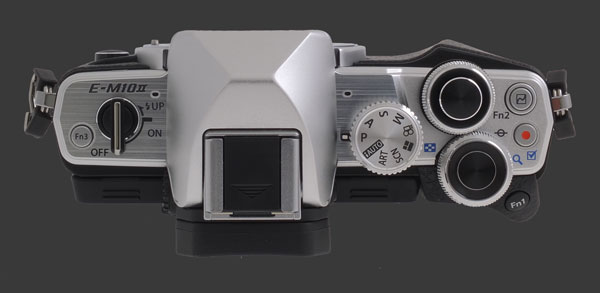
While there is one fewer button than on the mid-range E-M5 Mark II, the top plate remains crowded after Olympus pushed most controls to the right of the EVF. On the left, there is a small customizable button labelled Fn3. It can be set to control one of 27 functions, the same as the other 4 customizable buttons described further down in this review page. There are plenty of useful options there, including One-Touch WB, EC, HDR, AEB and DOF-Preview which can only be accessed using one of the function buttons. One frustration though is that ISO and WB are bundled together into a modal control. When a function button is pressed, the camera enters a mode where one control-dial selects ISO and another selects WB. The same function button needs to be pressed again to resume normal operation which slows things down.
There is a new rotating 3-position power-switch. There are obviously Off and On positions, plus a third spring-loaded one which pops up the built-in flash and bounces back to the on position. This is a good use of the power button real-estate. The EVF housing hosts a standard hot-shoe with the proprietary accessory-port long gone. It was mostly used to hook an EVF which is obviously not needed on an OM-D.
Jumping over the hump, the first control reached is a traditional mode-dial with 9 positions. All standard PASM modes are all present plus a fully automatic mode, called iAuto, along with Art Filter, Scene, Composite Image and Movie modes. The latter four modes each offer several sub-modes. In Movie mode, these sub-modes are PASM again. Luckily, since the E-M10 Mark II has a Movie mode, it can be ready and preview framing for video capture.
Next, dual controls-dials are found back-to-back. Both dials protrude well from the camera. They have a nice texture and good detents, making them easy to use even with gloves on and yet avoid accidental rotation. These control-dials can be configured independently for each mode, including Playback, and menus. In Manual mode, the only two choices are obviously Shutter and Aperture or vice-versa. In other modes, one of them controls the exposure-parameter, while the other must either be made redundant or adjust EC or FC.
Right at the outer corner of the top-plate, there is a customizable Fn2 button which adjusts tone-curves by default. Adjustment are made with the front control-dial for highlights and rear one for shadows. Tone-Curves are adjustable in 15 steps each. The effect is easily visible on-screen for shadows but barely so for highlights. Below Fn2 is the Video-Record button which is thankfully customizable. Given that there is a dedicated Video mode, this button is otherwise redundant. While you could capture video in Stills mode that way, it makes no sense to do so since the preview usually shows the wrong aspect-ratio.
Visible from the top yet not directly on the top-plate is a customizable button labelled Fn1. It can also be assigned any of the same 27 functions as other function buttons. One can use it for AE-L or AF-L which are sensible options if using the default control-dial assignments. However, one can set Fn1 to EC instead which allows both modal and modeless exposure-compensation. Press and let go for the former or hold for the latter. Otherwise, the E-M10 Mark II forces assignment of EC to one of the control-dials which is accident-prone and is best avoided for beginners.
A standard two-stage shutter-release is found at the center of the front control-dial. It has moderate travel and a distinct halfway point. There is another button mounted on the side of the EVF housing. This toggles the rear LCD between Capture Preview and Status Display mode. It does not do anything when using the EVF.
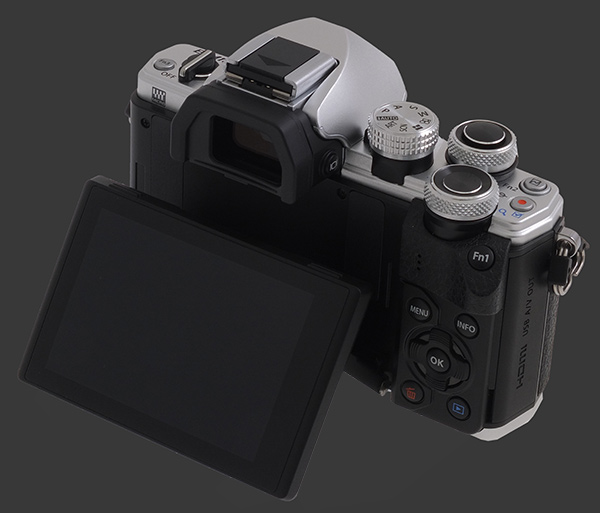
All remaining controls are found on the back of the camera which has a nearly identical layout as the E-M5 Mark II. Being relatively compact, space is limited around the 3" LCD. It looks quite busy with only space left for a small thumb-rest. The LCD is mounted on a sturdy double-hinge along the bottom edge of the camera. It folds downwards 45°or upward just passed 90°. This makes it easy take both low and high shots without widening the footprint of the camera. Do make sure that you are viewing the LCD head-on when shooting at odd angles since brightness drops off as the viewing angle shifts away from perpendicular.
Like all OM-D series cameras, the E-M10 Mark II features a built-in EVF with Eye-Start Sensor centered above the rear LCD. At 0.45" diagonally and 0.62X magnification, the one here is reasonably comfortable. It shows 100% coverage as one would expect from an EVF. Despite being slightly smaller, it boasts the same 2.4 megapixels which makes it incredibly sharp. The view is Exposure-Priority by default in M mode and updates according to EC. It is not Exposure-Priority in A or S mode though. One can toggle the EVF into S-OVF mode which stands for Simulated Optical ViewFinder. This could be useful in limited circumstances when brightness is expected to change widely during exposure.
The Menu and Info buttons are located below the thumb rest. The former enters and exists the menu system and the latter cycles over display options on the LCD or EVF, whichever is active at the time. No surprises here, just the way it should be. The menu itself though is very complex - up to 4 levels deep - and oddly organized. Those coming from previous Olympus camera will be familiar with its design yet will likely still find themselves going through the entire menu system looking for a setting from time to time.
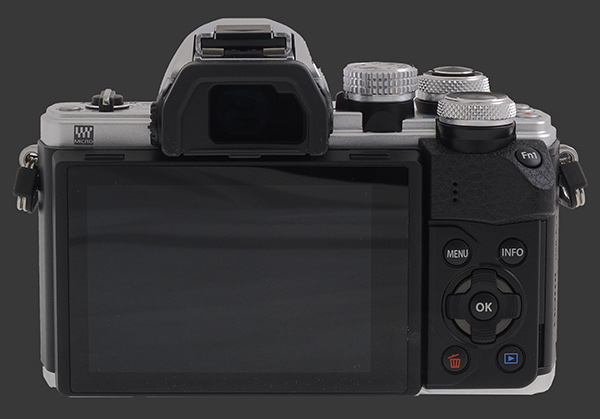
There is a 4-way controller with central OK button. By default, directions simply move the focus-point. This can be replaced by EC using Up, Focus-Point using Left and custom functions assigned to Right and Down. It is wise to assign one of this buttons to set the Drive Mode, while the other can be set to toggle between AF and MF, for instance.
The OK button invokes the Live Guide, the Live Control or Live Super Control-Panel or any number of them. These offer different ways to change certain camera settings without entering the menu system. The Live Super-Control Panel can set the most options including WB Fine-Tuning and most Image Parameters. To operate it, the 4-way controller or rear control-dial selects an option and the front control-dial sets the amount. When multiple controls are enabled, use the Info button to cycle between them.
Under the 4-way controller, there is a Delete and a Playback button. The Playback button behaves just as expected. The Delete button below the 4-way controller does nothing in Capture mode, even during instant review. To delete an image, one has to enter Playback mode. Although one can configure the E-M10 Mark II to enter Playback mode after each shot is taken which allows quick deletion but slows down shooting a little.
The large rear 3" LCD has 1 megapixels and is sufficiently sharp to confirm focus without magnifying. Visibility is excellent and the anti-reflective coating does a fantastic job. Color temperature and brightness for the LCD can be set. Due to the limited contrast of the display, nuances in highlights are hard to see, so images may appear over-exposed without being so. The preview on the LCD is not Exposure-Priority, although it shows a good approximation in Manual exposure mode. In other modes, it shows the metered exposure offset by EC. The Live-Histogram is unfortunately based on display-brightness and is only reliable in M mode.
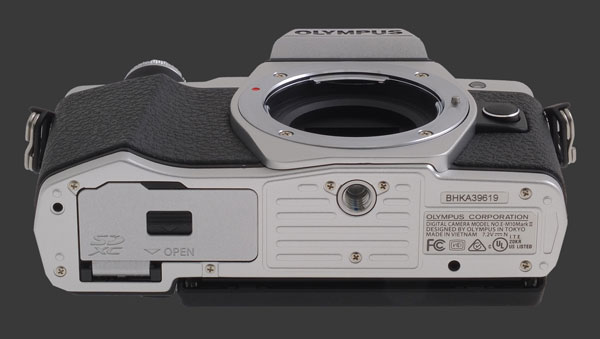
These is a single door at the bottom of the camera to cover the combined battery and memory card compartment. The battery is relatively small and space for the memory card slot is tight. There is also a metal tripod socket inline with the optical center of the lens which is ideal for panoramic photography.
The OM-D E-M10 Mark II shows generally good usability for a camera this small. There are certainly plenty of controls and a high level of customization. Still, there are some inefficiencies. The modality of EC, ISO and WB is a shame, although at least EC can be controlled modelessly. There are so many Drive Modes that it takes a while to change between Single-Shot and the Self-Timer for instance. Interestingly, it comes in a whopping 9 varieties, 3 of those being customizable! It would haven been great if it were possible to control ISO with one of the dials in semi-automatic mode too.
 |
Please Support Neocamera
All information on Neocamera is provided free of charge yet running this website is a huge endeavor. Purchases made via affiliate links found throughout the site help keep it running and up-to-date. There is no additional cost to you, so please consider buying via these links to our affilates:
Thank you for your support!
Olympus E-M10 Mark II Highlights

Sensor-Size: 17 x 13mm

Actual size when viewed at 100 DPI
| 16 Megapixels Mirrorless | ISO 100-25600 |
| Micro Four-Thirds Mount 2X FLM | Shutter 1/16000-60s |
| 5-Axis Built-in Stabilization, 4-Stop Improvement | Full manual controls, including Manual Focus |
| 0.45" Built-in EVF 2.4 Megapixels (0.62X) | Custom white-balance with 2 axis fine-tuning |
| Automatic Eye-Start sensor | Spot-Metering |
| 2 Axis Digital Level | Hot-Shoe |
| Built-in Dust Reduction | Lithium-Ion Battery |
| 8.5 FPS Drive, 36 Images | Secure Digital Extended Capacity |
| 1920x1080 @ 60 FPS Video Recording | |
| 3" LCD 1 Megapixels |
Updates
2025.11.13

Best Gifts for Photographers in 2025 by Budget
The annual Neocamera Photography Gift Guide updated to 2025. Find great gifts for photographers with any price budget.
2025.07.07

Stellar Photo Recovery Review
Review of Stellar Photo Recovery V12. This Windows and MacOS software can recover photos and videos in a huge number of formats from memory cards, USB drives, SSDs and HHDs.
2025.05.14

Huion Kamvas 13 Gen 3 Review
In-Depth review of the Huion Kamvas 13 Gen 3 Pen Display Tablet for photographers and graphic artists.
2025.01.18

Fujifilm GFX 2025 Lens Roundup
Lens Review roundup of Fujifilm GFX Medium-Format lenses. Quality, performance and handling of the GF20-35mm F/4R WR, GF30mm F/3.5 Tilt-Shift and the GF55mm F/1.7.
2024.11.18

Best 2024 Photography Gifts for Every Budget
Great gifts for photographers and photo enthusiasts selected for every budget among the best products of 2024.
2024.08.07

Eye Protection Tips for Professional Photographers
The four main considerations for professional photographers regarding eyewear.
2024.07.14

Fujifilm X100VI Review
Flagship fixed-lens compact digital camera with a 40 MP sensor and Image-Stabilization, a first for the series. Retro design featuring dual control-dials, plus direct ISO, Shutter-Speed and EC dials. Its hybrid viewfinder can switch between EVF and OVF mode.
2024.05.09

Fujifilm GFX100 II Review
Flagship 102 Megapixels Medium-Format Mirrorless Digital Camera with 8-Stop 5-Axis IBIS, 8 FPS Drive, 8K Video and 400 MP Super-Resolution capture in a weatherproof and freezeproof body with dual control-dials and dual memory-card slots.
2024.04.03

Fujifilm X-T5 Review
Newest Fujifilm flagship boasting a 40 MP APS-C sensor, 5-axis IBIS with 7-stop efficiency, 15 FPS continuous drive, 6.2K Video capture, dual control-dials and dual SDXC UHS-II slots in a sturdy weatherproof and freezeproof body.
2023.11.20

Best Digital Cameras of 2023
Find out which are the Best Digital Cameras of 2023. All the new Mirrorless Digital Cameras from entry-level to high-end professional.
2023.07.10

Fujifilm X-H2 Review
40 Megapixels APS-C Hybrid Mirrorless Digital Camera with 7-stop IBIS. Fastest shutter ever and 8K video capture. Large builtin EVF with 0.8X magnification and 5.8 MP, plus an Eye-Start Sensor. Packed with features and large number of controls in a weatherproof and freezeproof body.
2023.05.07

Sony FE 20-70mm F/4G Review
Review of the unique Sony FE 20-70mm F/4G lens. The optical zoom of this lens spans ultra-wide-angle and medium focal-length coverage, making it one of the most versatile Full-Frame lenses on the market.












